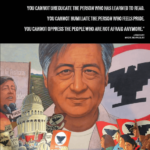Students explore the founding era legacies of assembly and petition and how those legacies informed the creation of these often-overlooked aspects of the First Amendment. They will complete a close reading activity to compare and contrast ideas presented in the Interactive Constitution and describe the ways these rights have been interpreted by the Court and used by citizens at various points throughout U.S. history. They will evaluate the constitutionality of assembly and petition rights in the modern era through an in-class, civil dialogue addressing questions about time, place, and manner restrictions; counter-protests; protests on college campuses; and other relevant assembly and petition questions.
The 19th Amendment: Part 2 Podcast
The Nineteenth Amendment was first introduced to Congress in 1878. It took over four decades of pleas, protests, petitions and speeches to finally get it ratified. We’re told that the Nineteenth granted all women the right to vote in America — but this was not the case in practice. How did the divides in the suffrage movement define the fight for women’s enfranchisement? And how did that amendment finally get passed? With a stern note from someone’s mom.
Our guests are once again historians Martha Jones of John Hopkins University, Laura Free of Hobart and William Smith Colleges and Lisa Tetrault of Carnegie Mellon University.
This short episode includes a one-page Graphic Organizer for students to take notes on while listening, as well as discussion questions on the back side.
Rights of Farm Workers: Labor Leaders César Chávez and Dolores Huerta

March 31 is César Chávez Day and April 10 is Dolores Huerta Day. Use these K-12 lesson plans and resources to celebrate the life and legacy of these civil rights and labor activists. Topics span their co-founding of the United Farm Workers union, their use of nonviolent protests to fight for the rights of laborers and includes other change-makers like Lucas Benitez and Librada Paz.
“Story” from Essential Lens: Analyzing Photographs Across the Curriculum
Every photograph tells a story: Stories of struggle. Stories of beauty. Stories of community and culture. This video offers stories of three people and what compels them to do what they do. Hear from a high school teacher using the Protests and Politics photo collection from this resource (link to collection and big ideas on page), a National Geographic photo editor, and photographer Danny Wilcox Frazier who discusses his work, which focuses on marginalized communities across the United States.
LGBTQ Activism and Contributions Primary Source Set
The lives, freedom struggles, and social and cultural contributions of lesbian, gay, bisexual, transgender, and queer (LGBTQ) people make up a rich part of the history of the United States, and primary sources from the Library of Congress provide valuable opportunities to explore individuals, movements, and events from the nation’s LGBTQ history.
Women & the American Story: Growth and Turmoil, 1948-1976
This free curriculum unit from the New-York Historical Society explores the decades following World War II and considers the action that different groups took to advocate for their rights. Materials examine how shifting political and social ideologies impacted women’s lives and the roles women played in the wide array of activist-led movements that formed in the 1960s and 1970s.
Civil Rights Movement: Sit-Ins
By the 1960s, the Civil Rights movement was growing in the U.S. Leaders such as Martin Luther King Jr. employed non-violent methods of protesting. On February 1, 1960 students in Greenville, NC engaged in a new peaceful tactic, a sit-in. This launched a wave of sit-ins across the country. In this lesson, students will hear about the circumstances that unfolded that day and hits impact on the country.
From Suffragist Sashes to Antiwar Armbands
In a 19th Amendment video, produced by the Administrative Office of the U.S. Courts for use in classrooms, courtrooms, and the distance-learning space, an unlikely connection is made between two rights activists from different eras. Suffragette Virginia Minor and Vietnam war protester Mary Beth Tinker were separated by 100 years, but their passions came together in the legal history of the nation and of St. Louis, where they each worked through the courts to make social change. Both cases were decided – with different outcomes – by the Supreme Court of the United States.
The Vietnam War Lesson Guide
Explore classroom lesson plans related to Ken Burns’s and Lynn Novick’s 10-part, 18-hour documentary series, The Vietnam War, which tells the story of one of the most consequential, divisive and controversial events in American history. The series explores the human dimensions of the war through the testimony of nearly 80 witnesses from all sides.
From Provocative to Productive: Teaching Controversial Topics
Get first steps for creating a respectful yet vibrant environment for students to explore diverse ideas on controversial topics, from politics to profanity, religion to racism. Four guidelines and a debate leader checklist provide a foundation for those seeking to steer productive conversations about controversial subjects.